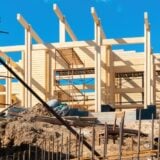The Mortgage Bankers Association said that the combination of loans in foreclosure and at least one payment overdue was 15.02% on a non-seasonally adjusted basis, the highest ever seen in its survey which goes back to 1972.
However, the delinquency rate for mortgage loans on one-to-four-unit residential properties fell to a seasonally adjusted rate of 9.47% of all loans outstanding as of the end of the fourth quarter of 2009, down slightly from 9.64% in the third quarter, but up from 7.88% in the same quarter of 2008, the MBA said in its National Delinquency Survey.
The percentage of loans on which foreclosure actions were started fell to 1.2% in the fourth quarter, down from 1.42% in the third quarter, but up from 1.08% in the same quarter of 2008.
The US foreclosure inventory rate for all loans was 4.58% in the fourth quarter, up from 4.47% in the third quarter and from 3.3% in the fourth quarter of 2008. Overall the survey found nearly 4.3 million mortgages were either delinquent or in foreclosure in the fourth quarter of 2009.
The MBA reports adds that 9.67% of the nation’s more than 44.4 million mortgages are seriously delinquent, that is at least 90 days overdue or in foreclosure.
Although fewer new delinquencies in the quarter brought the overall rate down by the end of the year, the bucket of serious delinquencies of 90 or more days swelled. And with fewer seriously delinquent loans moving into foreclosure, the shadow inventory of US properties bound for foreclosure looks likely to rise, the MBA said.
As it stands, clearing the backlog of shadow inventory properties is likely to take almost three years, according to credit rating agency Standard & Poor’s.
‘The good news is that it looks like the problems are going down. While long term delinquencies are still increasing. What we saw this quarter frankly surprised us,’ said MBA chief economist Jay Brinkmann.
MBA noted a surprising decline in new delinquencies entering the system in the final quarter of 2009, a break from the seasonal trend. ‘The difference between the third and fourth quarters has never been negative to this extent,’ Brinkmann added.
‘This drop is important because 30 day delinquencies have historically been a leading indicator of serious delinquencies and foreclosures. With fewer new loans going bad, the pool of seriously delinquent loans and foreclosures will eventually begin to shrink once the rate at which these problems are resolved exceeds the rate at which new problems come in. It also gives us growing confidence that the size of the problem now is about as bad as it will get,’ he explained.
Offsetting the good news in new delinquencies is the rate of serious delinquencies, which rose from the previous quarter to 9.67%. At the same time, foreclosure starts dropped to 1.2% of loans. ‘That would normally be good news. But now it means loans are building up in the 90-day delinquent bucket. Some percentage of these serious delinquencies are bound to end up in foreclosure,’ said Brinkmann.
Record number of US real estate loans overdue or in foreclosure, latest data shows
- Share this
- Share on Facebook
- Share on Twitter
- Share on LinkeIn





